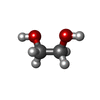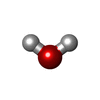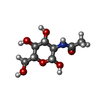+Search query
-Structure paper
| Title | Short CDRL1 in intermediate VRC01-like mAbs is not sufficient to overcome key glycan barriers on HIV-1 Env. |
|---|---|
| Journal, issue, pages | J Virol, Vol. 98, Issue 10, Page e0074424, Year 2024 |
| Publish date | Oct 22, 2024 |
 Authors Authors | Parul Agrawal / Maria L Knudsen / Anna MacCamy / Nicholas K Hurlburt / Arineh Khechaduri / Kelsey R Salladay / Gargi M Kher / Latha Kallur Siddaramaiah / Andrew B Stuart / Ilja Bontjer / Xiaoying Shen / David Montefiori / Harry B Gristick / Pamela J Bjorkman / Rogier W Sanders / Marie Pancera / Leonidas Stamatatos /   |
| PubMed Abstract | VRC01-class broadly neutralizing antibodies (bnAbs) have been isolated from people with HIV-1, but they have not yet been elicited by vaccination. They are extensively somatically mutated and ...VRC01-class broadly neutralizing antibodies (bnAbs) have been isolated from people with HIV-1, but they have not yet been elicited by vaccination. They are extensively somatically mutated and sometimes accumulate CDRL1 deletions. Such indels may allow VRC01-class antibodies to accommodate the glycans expressed on a conserved N276 N-linked glycosylation site in loop D of the gp120 subunit. These glycans constitute a major obstacle in the development of VRC01-class antibodies, as unmutated antibody forms are unable to accommodate them. Although immunizations of knock-in mice expressing human VRC01-class B-cell receptors (BCRs) with specifically designed Env-derived immunogens lead to the accumulation of somatic mutations in VRC01-class BCRs, CDRL1 deletions are rarely observed, and the elicited antibodies display narrow neutralizing activities. The lack of broad neutralizing potential could be due to the absence of deletions, the lack of appropriate somatic mutations, or both. To address this point, we modified our previously determined prime-boost immunization with a germline-targeting immunogen nanoparticle (426c.Mod.Core), followed by a heterologous core nanoparticle (HxB2.WT.Core), by adding a final boost with a cocktail of various stabilized soluble Env trimers. We isolated VRC01-like antibodies with extensive somatic mutations and, in one case, a seven-amino acid CDRL1 deletion. We generated chimeric antibodies that combine the vaccine-elicited somatic mutations with CDRL1 deletions present in human mature VRC01 bnAbs. We observed that CDRL1 indels did not improve the neutralizing antibody activities. Our study indicates that CDRL1 length by itself is not sufficient for the broadly neutralizing phenotype of this class of antibodies. IMPORTANCE: HIV-1 broadly neutralizing antibodies will be a key component of an effective HIV-1 vaccine, as they prevent viral acquisition. Over the past decade, numerous broadly neutralizing antibodies (bnAbs) have been isolated from people with HIV. Despite an in-depth knowledge of their structures, epitopes, ontogenies, and, in a few rare cases, their maturation pathways during infection, bnAbs have, so far, not been elicited by vaccination. This necessitates the identification of key obstacles that prevent their elicitation by immunization and overcoming them. Here we examined whether CDRL1 shortening is a prerequisite for the broadly neutralizing potential of VRC01-class bnAbs, which bind within the CD4 receptor binding site of Env. Our findings indicate that CDRL1 shortening by itself is important but not sufficient for the acquisition of neutralization breadth, and suggest that particular combinations of amino acid mutations, not elicited so far by vaccination, are most likely required for the development of such a feature. |
 External links External links |  J Virol / J Virol /  PubMed:39240111 / PubMed:39240111 /  PubMed Central PubMed Central |
| Methods | EM (single particle) / X-ray diffraction |
| Resolution | 2.01 - 4.2 Å |
| Structure data | EMDB-44510, PDB-9bge:  PDB-9b44: |
| Chemicals |  ChemComp-EDO:  ChemComp-HOH:  ChemComp-NAG: |
| Source |
|
 Keywords Keywords | IMMUNE SYSTEM / HIV Antibody / HIV / antibody |
 Movie
Movie Controller
Controller Structure viewers
Structure viewers About Yorodumi Papers
About Yorodumi Papers





 Homo sapiens (human)
Homo sapiens (human)
 human immunodeficiency virus 1
human immunodeficiency virus 1
